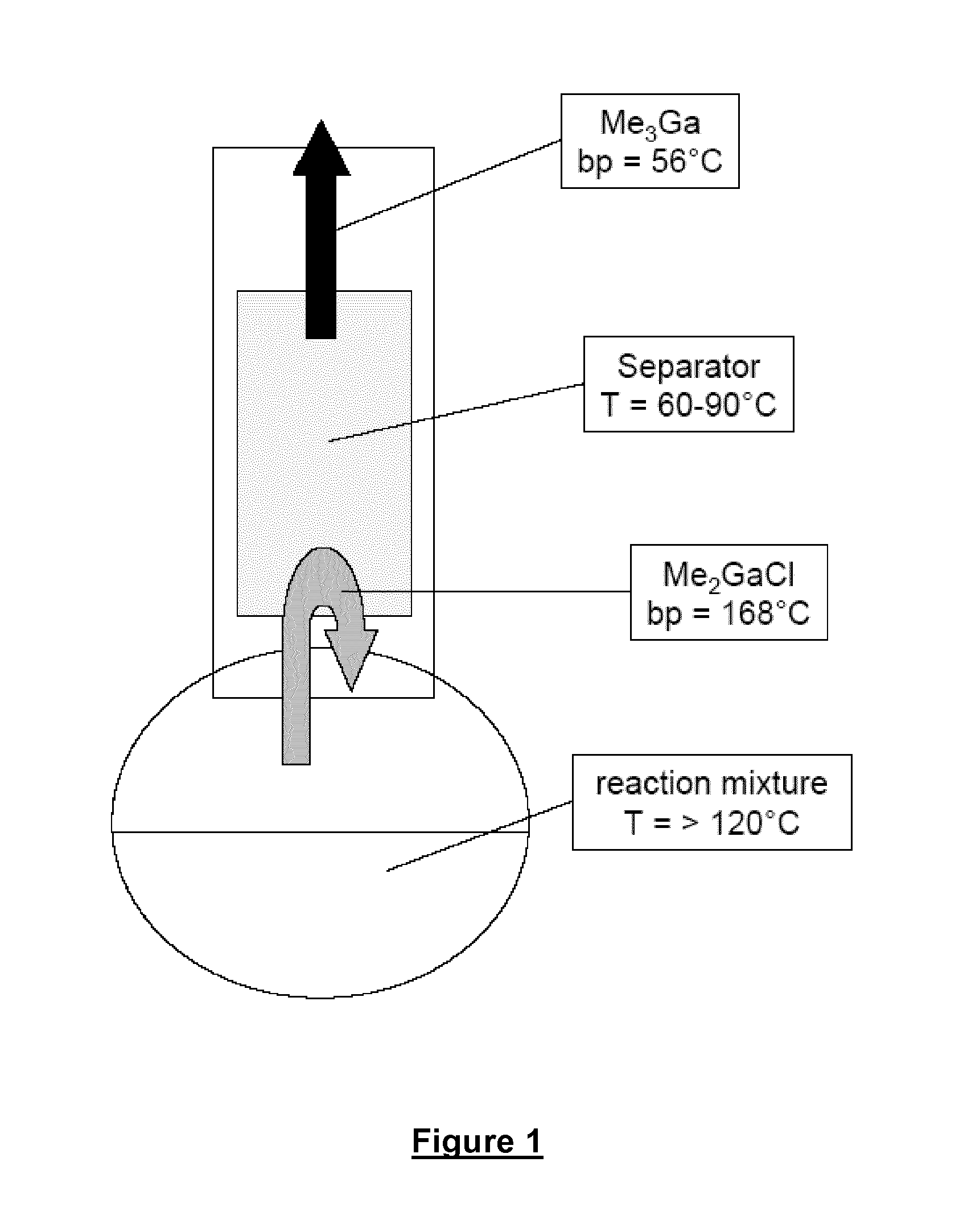Process for preparing trialkylgallium compounds
a technology of trialkylgallium and compound, which is applied in the field of process for preparing trialkylgallium compounds, can solve the problems of difficult separation, unsuitable industrial use of the process, and restrict the usability of the process, and achieve the effect of carrying out economically and inexpensively
- Summary
- Abstract
- Description
- Claims
- Application Information
AI Technical Summary
Benefits of technology
Problems solved by technology
Method used
Image
Examples
example 1
Preparation of Trimethylgallium (TMG)
[0094]117.3 g (0.57 mol, 1 equivalent) of methylaluminium sesquichloride (Me3Al2Cl3, Chemtura Organometallics GmbH, Bergkamen, DE), 46.6 g (0.80 mol, 1.4 equivalents) of dry NaCl (Merck, water content <5 ppm) and 25.5 g (0.34 mol, 0.6 equivalent) of dry KCl (Merck, water content <5 ppm) are placed under inert gas (argon, purity 6.0) in a 500 ml four-neck flask provided with stirrer, heatable dropping funnel and a separator maintained at 70° C. and also a further outlet.
[0095]While stirring, 100.0 g (0.57 mol) of molten GaCl3 (high-purity, MCP Group, Tilly, BE) are added from a dropping funnel heated to 90° C. in such a way that the temperature in the reaction mixture does not exceed 120° C. The ratio of equivalents of GaCl3 to Me3Al2Cl3 is 1:1.
[0096]During the subsequent heating up, Me3Ga can be isolated above about 155° C. The end point of the isolation of the product via the separator is identified by means of a sharp increase in the internal t...
example 2
[0098]Preparation of TMG (with Re-Use)
[0099]183.1 g (1.04 mol) of GaCl3, 92.9 g (1.59 mol) of dry NaCl, 50.8 g (0.68 mol) of dry KCl and also 40.4 g (0.3 mol) of Me2GaCl and 5.5 g (0.05 mol) of Me3Ga (isolated mixture from previous experiment) are placed under inert gas in a 500 ml four-neck flask provided with stirrer, dropping funnel and a separator maintained at 70° C. and also a further outlet.
[0100]While stirring 233 g (1.14 mol) of Me3Al2Cl3 are added in such a way that the temperature in the reaction mixture does not exceed 120° C. During subsequent heating up, Me3Ga is isolated (99.3 g, corresponding to a direct yield of 61.7%).
[0101]When the reaction temperature reaches 190° C., the isolation of the product by the separator is stopped and the remaining gallium-containing compounds (residue) are isolated from the residual mixture via the second outlet with application of a reduced pressure (70.0 g, mixture of Me3Ga and Me2GaCl).
[0102]The total yield is 64.0% of Me3Ga. Taking...
example 3
Preparation of TMG (Ratio of Equivalents=1:3)
[0104]45.0 g (0.26 mol) of GaCl3, 62.7 g (1.07 mol, 4.2 equivalents) of dry NaCl and 34.3 g (0.46 mol, 1.8 equivalents) of dry KCl are placed under argon in a 500 ml four-neck flask provided with stirrer, dropping funnel and a separator maintained at 70° C.
[0105]While stirring, 162.8 g (0.79 mol, 3 equivalents) of Me3Al2Cl3 are added in such a way that the temperature in the reaction mixture does not exceed 120° C. During subsequent heating up, Me3Ga is isolated (26.6 g; corresponding a direct yield of 88% of Me3Ga).
[0106]After the isolation of product by the separator is complete, the remaining gallium-containing compounds are removed from the residual mixture via a second outlet with application of a reduced pressure (6.9 g).
[0107]In total, 99.0% of Me3Ga and 0.9% of Me2GaCl are isolated, and the total conversion (based on Ga) is 99.9%. The isolated crude Me3Ga contains 0.7 wt.-% of Me2GaCl and 1.4 wt.-% of Me2AlCl (measured by means of...
PUM
| Property | Measurement | Unit |
|---|---|---|
| boiling point | aaaaa | aaaaa |
| temperature | aaaaa | aaaaa |
| temperature | aaaaa | aaaaa |
Abstract
Description
Claims
Application Information
 Login to View More
Login to View More - R&D
- Intellectual Property
- Life Sciences
- Materials
- Tech Scout
- Unparalleled Data Quality
- Higher Quality Content
- 60% Fewer Hallucinations
Browse by: Latest US Patents, China's latest patents, Technical Efficacy Thesaurus, Application Domain, Technology Topic, Popular Technical Reports.
© 2025 PatSnap. All rights reserved.Legal|Privacy policy|Modern Slavery Act Transparency Statement|Sitemap|About US| Contact US: help@patsnap.com

